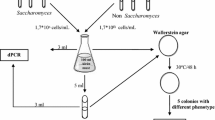Abstract
Wine fermentations are complex microbial ecosystems, with both yeasts and bacteria taking part in the transformation process with their metabolic activities. Traditional microbiological methods do not allow a complete understanding of the microbial ecology of complex systems. This is due mainly to the capacity of certain microorganisms to grow on microbiological media preferentially with respect to others. Moreover, with these methods, stressed or damaged cells cannot be detected on the plates. In the last 10 years new methods based on the analysis of nucleic acids (DNA and RNA) extracted directly from the sample without the need for microbial cultivation have been developed. A method often used in this type of study is the polymerase chain reaction (PCR) coupled with denaturing gradient gel electrophoresis (DGGE). This paper aims to report the most important contributions of PCR-DGGE to the study of microbiological ecology during wine fermentation.
Similar content being viewed by others
References
Andorrà I, Landi S, Mas A, Guillamom JM, Esteve-Zarzoso B (2008) Effect of oenological practices on microbial populations using culture-independent techniques. Food Microbiol 25:849–856
Andorrà I, Landi S, Mas A, Esteve-Zarzoso B, Guillamom JM (2009) Effect of fermentation temperature on microbial population evolution using culture-independent and dependent techniques. Food Res Int 43:773–779. doi:10.1016/j.foodres.2009.11.014
Barnett JA, Delaney MA, Jones E, Magson AB, Winch B (1972) The numbers of yeasts associated with wine grapes of Bordeaux. Arch Microbiol 83:52–55
Bottari B, Ercolini D, Gatti M, Neviani E (2006) Application of FISH technology for microbiological analysis: current state and prospects. Appl Microbiol Biotechnol 73:485–494
Cocolin L, Mills DA (2003) Wine yeast inhibition by sulfur dioxide: a comparison of culture-dependent and independent methods. Am J Enol Vitic 54:125–130
Cocolin L, Bisson LF, Mills DA (2000) Direct profiling of the yeast dynamics in wine fermentations. FEMS Microbiol Lett 189:81–87
Cocolin L, Heisey A, Mills DA (2001) Direct identification of the indigenous yeasts in commercial wine fermentations. Am J Enol Vitic 52:49–53
Cocolin L, Manzano M, Rebecca S, Comi G (2002) Monitoring of yeast population changes during continuous wine fermentation by molecular methods. Am J Enol Vitic 53:24–27
Cocolin L, Rantsiou K, Iacumin L, Zironi R, Comi G (2004) Molecular detection and identification of Brettanomyces/Dekkera bruxellensis and Brettanomyces/Dekkera anomalus in spoiled wines. Appl Environ Microbiol 70:1347–1355
Dahllof I, Baillie H, Kjelleberg S (2000) rpoB-based microbial community analysis avoids limitations inherent in 16S rRNA gene intraspecies heterogeneity. Appl Environ Microbiol 66:3376–3380
Di Maro E, Ercolini D, Coppola S (2007) Yeast dynamics during spontaneous wine fermentation of the Catalanesca grape. Int J Food Microbiol 117:201–210
Donèche BJ (1993) Botritized wines. In: Fleet GH (ed) Wine microbiology and biotechnology. Harwood, New York, pp 327–351
Erasmus DJ, van der Merwe GK, van Vuuren HJJ (2003) Genome-wide expression analyses: metabolic adaptation of Saccharomyces cerevisiae to high sugar stress. FEMS Yeast Res 3:375–399
Ercolini D (2004) PCR-DGGE fingerprinting: novel trategies for detection of microbes in food. J Microbiol Methods 56:297–314
Fleet GH (1993) Wine microbiology and biotechnology. Harwood, New York
Hugenholtz P, Goebel BM, Pace NR (1998) Impact of culture-independent studies on the emerging phylogenetic view of bacterial diversity. J Bacteriol 180:4765–4774
Lopez I, Ruiz-Larrea F, Cocolin L, Orr E, Phister T, Marshall M, VanderGheynst J, Mills DA (2003) Design and evaluation of PCR primers for analysis of bacterial populations in wine by denaturing gradient gel electrophoresis. Appl Environ Microbiol 69:6801–6807
Manzano M, Cocolin L, Longo B, Comi G (2004) PCR-DGGE differentiation of strains of Saccharomyces sensu stricto. Antonie van Leeuwenhoek 85:23–27
Manzano M, Cocolin L, Iacumin L, Cantoni C, Comi G (2005) A PCR-TGGE (temperature gradient gel electrophoresis) technique to assess differentiation among enological Saccharomyces cerevisiae strains. Int J Food Microbiol 101:333–339
Mills DA, Johannsen E, Cocolin L (2002) Yeast diversity and persistence in botrytis-affected wine fermentations. Appl Environ Microbiol 68:4884–4893
Muyzer G, Smalla K (1998) Application of denaturing gradient gel electrophoresis (DGGE) and temperature gradient gel electrophoresis (TGGE) in microbial ecology. Antonie van Leeuwenhoek 73:127–141
Nisiotou AA, Spiropoulos AE, Nychas G-JE (2007) Yeast comminuty structures and dynamics in healthy and Botrytis-affected grape must fermentation. Appl Environ Microbiol 73:6705–6713
Pace NR (1997) A molecular view of microbial diversity and the biosphese. Science 276:734–740
Prakitchaiwattana CJ, Fleet GH, Heard GM (2004) Application and evaluation of denaturing gradient gel electrophoresis to analyse the yeast ecology of wine grapes. FEMS Yeast Res 4:865–877
Rantsiou K, Campolongo S, Rolle L, Cocolin L (2009) Yeast populations dynamics in natural and inoculated sweet wine fermentations. In: Proceedings of the 60th Annual Meeting of the American Society for Viticulture and Enology, Napa, CA, 23–26 June 2009
Renouf V, Falcou M, Miot-Sertier C, Perello MC, De Revel G, Lonvaud-Funel A (2006a) Interactions between Brettanomyces bruxellensis and other yeast species during the initial stages of winemaking. J Appl Microbiol 100:1208–1219
Renouf V, Classe O, Miot-Sertier C, Lonvaud-Funel A (2006b) Lactic acid bacteria evolution during winemaking: use of rpoB gene as a target for PCR-DGGE analysis. Food Microbiol 23:136–145
Sipiczki M (2003) Candida zemplinina sp. nov., an osmotolerant and psychrotolerant yeast that ferments sweet botrytized wines. Int J Syst Evol Microbiol 53:2079–2083
Urso R, Rantsiou K, Dolci P, Rolle L, Comi G, Cocolin L (2008) Yeast biodiversity and dynamics during sweet wine production as determined by molecular methods. FEMS Yeast Res 8:1053–1062
Xufre A, Albergaria H, Inacio J, Spencer-Martins I, Girio F (2006) Application of fluorescence in situ hybridization (FISH) to the analysis of yeast population dynamics in winery and laboratory grape must fermentations. Int J Food Microbiol 108:376–384
Author information
Authors and Affiliations
Corresponding author
Additional information
This paper is part of the special issue "Wine Microbiology and safety: From the vineyard to the bottle (Microsafetywine), 19-20 November, 2009, Martina Franca (Italy)
Rights and permissions
About this article
Cite this article
Cocolin, L., Campolongo, S., Alessandria, V. et al. Culture independent analyses and wine fermentation: an overview of achievements 10 years after first application. Ann Microbiol 61, 17–23 (2011). https://doi.org/10.1007/s13213-010-0076-6
Received:
Accepted:
Published:
Issue Date:
DOI: https://doi.org/10.1007/s13213-010-0076-6




